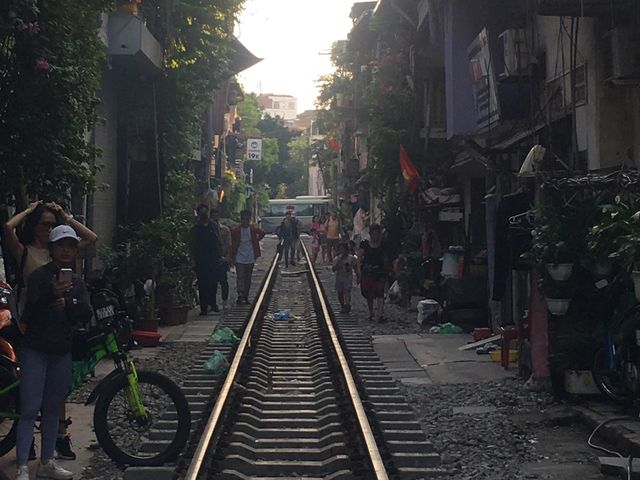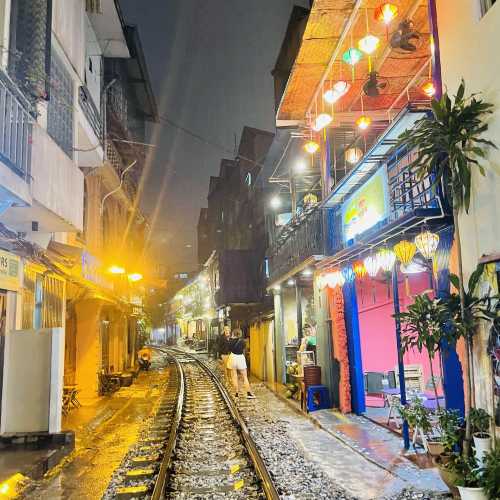Quan Thanh Temple: A Historical and Cultural Gem of Hanoi Overview Quan Thanh Temple (Đền Quán Thánh), also known as Tran Vu Temple, is one of Hanoi's oldest and most sacred Taoist temples. Established in the 11th century during the Ly Dynasty, it is part of the "Four Sacred Temples of Thang Long Citadel," guarding the northern entrance of the ancient capital. The temple is dedicated to Huyen Thien Tran Vu (Xuan Wu), the Taoist deity of the north, symbolized by a serpent and turtle. Located near West Lake at the intersection of Quan Thanh and Thanh Nien Streets, it remains a key spiritual and tourist site in Hanoi. Historical Significance - Founding: Built in 1010 under Emperor Ly Thai To to celebrate the relocation of Vietnam’s capital to Thang Long (modern Hanoi). - Sacred Role: One of four temples (alongside Bach Ma, Kim Lien, and Voi Phuc) positioned to protect the city from malevolent spirits and invaders. - Renovations: Restored multiple times, most notably in 1677 (when the iconic bronze statue was added) and 1893, blending Ly, Le, and Nguyen Dynasty architectural styles. Architecctural Highlights 1. Bronze Statue of Tran Vu: - Cast in 1677 by artisans from Ngũ Xã village, this 3.96-meter-tall, 3.6-ton black bronze statue depicts Tran Vu seated on a turtle, wielding a sword entwined by a serpent. It is Vietnam’s second-largest bronze statue and a masterpiece of 17th-century craftsmanship. - The deity’s symbols—the turtle (protection) and serpent (wealth)—reflect Taoist and Vietnamese folklore traditions. 2. Structural Features: - Three-Gate Entrance: Adorned with phoenixes and unicorns, typical of Nguyen Dynasty design. - Courtyard: Shaded by a centuries-old banyan tree, with a brick oven for burning joss paper during festivals. - Ancient Artifacts: Includes a 1.15-meter bronze bell, wood carvings of mythical creatures, and over 60 parallel poems in Chinese characters. Cultural and Spiritual Practices - Festivals: Locals visit during Tet (Lunar New Year) and on the 1st/15th lunar month days to pray for health, luck, and prosperity. - Syncretism: Though Taoist, the temple integrates Buddhist and Confucian elements, reflecting Vietnam’s religious blending. - Martial Arts: Hosts Vovinam classes, honoring Tran Vu’s association with martial prowess. Visitor Information - Location: 190 Quan Thanh Street, Ba Dinh District. - Hours: - Daily: 8:00 AM – 5:00 PM. - Extended hours on Tet Eve and lunar month days (6:00 AM – 8:00 PM). - Entry Fee: 10,000 VND (adults); 5,000 VND (students/children). - Dress Code: Modest attire covering shoulders and knees. Best Time to Visit: Early morning for tranquility, or during Tet (January–February) for vibrant rituals. Nearby Attractions 1. Tran Quoc Pagoda: Vietnam’s oldest pagoda, located on West Lake. 2. Ho Chi Minh Mausoleum: 1 km away, housing the embalmed leader. 3. Temple of Literature: Vietnam’s first university, dedicated to Confucius. Conclusion Quan Thanh Temple is a testament to Hanoi’s rich spiritual heritage and architectural ingenuity. Its iconic bronze statue, serene ambiance, and historical depth make it a must-visit for those exploring Vietnam’s cultural legacy. Whether admiring its artistry or participating in age-old rituals, the temple offers a profound glimpse into the soul of Hanoi. #travel #vietnam #hanoi #temple
Ice Lim 33
Popular Trip Moments
Dine with me at the World’s Cheapest ⭐️ Michelin Restaurant | Red River | Hanoi, Vietnam 🇻🇳! Highlights and recommendations 🤩 | 🇻🇳 Hanoi: A City of Contrasts, Where Every Moment is an Adventure 🌆 | Ho Chi Minh's Stilt House | Thong Nhat Park, Hanoi | 【Hanoi】Cong Cafe | Must-try coconut coffee, a great spot by the Hoan Kiem Lake | Vietnam | I Captured the Bountiful Vietnam in 9 Photos | A Cozy Escape at A Little Vintage Coffee Shop in Hanoi | Quan Thanh Pagoda | Ran Temple | Hanoi-Sapa travel plan 5 days 4 nights | Hoan Kiem Lake | Lotus flowers in HaNoi | The most surprising Vietnamese restaurant in Hanoi👍 | Hanoi Train Street | Michelin French restaurant in Hanoi for 2 consecutive years | Vietnam🇻🇳Hanoi Old Town painted walls whisper about the old times of Hanoi | Hanoi 🇻🇳 Thang Long Imperial Citadel | Thang Long Citadel | [🇻🇳Hanoi] Bat Trang Village | Giving away a full 5-day, 4-night travel plan for Northern Vietnam | Hanoi Little Charm Hanoi Hostel | [Hanoi] 5 things I enjoyed doing | An ordinary day in Hanoi, Vietnam | 🇻🇳 West Lake Walk: How I Circled the Largest Lake in Hanoi 🚶♂️ | Hanoi Hotels | A Night in a Golden Filter | You must stay here when you go to Hanoi🩵 | Hanoi Confucian Temple Imperial College 🇻🇳
Popular Travel Types
Popular Destinations
Jiuzhaigou Travel | Adelaide Travel | Negombo Travel | Guilin Travel | Kunming Travel | Coffs Harbour Travel | Kolkata Travel | Lijiang Travel | Dubbo Travel | Cebu Travel | Kotor Travel | Bandung City Travel | Haikou Travel | Bali Travel | Vienna Travel | Wagga Wagga Travel | Thiruvananthapuram Travel | Florence Travel | Medan Travel | Liuzhou Travel | Inn District Travel | Patrick County Travel | Ouest Travel | Lakeshore Travel | Mid Suffolk District Travel | Agawa District Travel | Toyota Travel | Pineland Travel | Wangjiang Travel | Boroondara City Travel
Recommended Attractions at Popular Destinations
Bangkok attraction near me | Manila attraction near me | Tokyo attraction near me | Taipei attraction near me | Hong Kong attraction near me | Seoul attraction near me | Kuala Lumpur attraction near me | Los Angeles attraction near me | Shanghai attraction near me | New York attraction near me | Shenzhen attraction near me | Osaka attraction near me | Singapore attraction near me | London attraction near me | Guangzhou attraction near me | San Francisco attraction near me | Beijing attraction near me | Macau attraction near me | Bali attraction near me | Jakarta attraction near me | Paris attraction near me | Ho Chi Minh City attraction near me | Istanbul attraction near me | Phuket attraction near me | Chicago attraction near me | Seattle attraction near me | Toronto attraction near me | Orlando attraction near me | Cebu attraction near me | Chiang Mai attraction near me
Popular Attractions
Palace of Versailles | Huangpu River Cruise(Shiliupu Pier) | Louvre Museum | Penida Island | Walt Disney World Resort | Dreamworld | Puffing Billy Railway | Chao Phraya River | Tokyo Tower | Alas Harum Bali | Taronga Zoo Sydney | Meridian Cruise | Adelaide Zoo | Arashiyama | Hanshan Temple | Brijuni National Park | Itaewon-dong | Tianmen Mountain Cablecar | Put Gusara - Central Dalmatia Croatia - Theme Trails | Castello di Castel di Sangro | Săvârșin Royal Castle | Dawson Creek view | Roudlotut Mosque Tholibin | Grignon Disc Golf Course | Meister Gen Gen Golf Club | Lake Apopka Loop Trailhead | Hessle Foreshore | Porta Vescovo | Shanghai Old Street | Zhujiajiao Ancient Town
Popular Restaurants in Hanoi
Red Bean Ma May | The Gourmet Corner | Essence Restaurant | Cha Ca Thang Long | Lu Wang carp | HOME Vietnamese Restaurant | Gia Restaurant | Quan An Ngon | d'LIONS Restaurant | Maison Sen | Highway4 Bar Restaurant | Pho 10 Ly Quoc Su(Co So 1) | Hotpot Story Restaurant | Cau Go Restaurant | JW Cafe | Salt n' Lime | Bamboo Bar | Banh Cuon Gia Truyen | Stellar Steakhouse | La Salsa Tapas bar&Restaurant | Hibana by Koki | El Gaucho-Argentinian Steakhouse | Banh Mi 25 | French Grill | ERA RESTAURANT | Mediterraneo | Jacksons Steakhouse | Cafe Duy Tri | Puku Cafe & Bar | Com Chay Nang Tam
Popular Ranked Lists
Popular Luxury Hotels in Kieni East | Popular Luxury Hotels in Nizwa | Top 6 Best Things to Do in Hinggan League | Top 10 Local Restaurants in Dayi | Top 3 Luxury Hotels in Tashkent | Popular Luxury Hotels Near Fukushima | Popular Luxury Hotels in Dhofar | Popular Luxury Hotels Near Tatsugo | Popular Premium Hotels Near Kinshasa | Popular Local Restaurants in Chongzuo | Top 3 Best Things to Do in Linxia Prefecture | Popular Local Restaurants in Guanling | Popular Luxury Hotels Near Varberg | Top 8 Best Things to Do in Baishan | Top 4 Local Restaurants in Fangchenggang | Popular Luxury Hotels Near Naxos | Popular Luxury Hotels Near Taean-gun | Popular Luxury Hotels Near Higashiagatsuma | Top 10 Luxury Hotels in Red Sea Governorate | Popular Best Things to Do in Shaoyang | Top 15 Local Restaurants in Yangcheng Lake | Top 5 Best Things to Do in Weinan | Top 6 Local Restaurants in Zhengding | Popular Best Things to Do in Lvliang | Top 10 Local Restaurants in Dandong | Top 3 Best Things to Do in Shengsi | Top 10 Local Restaurants in Mogan Mountain | Popular Best Things to Do in Suifenhe | Top 5 Best Things to Do in Xiangshan | Popular Luxury Hotels Near Montelimar
Payment Methods
Our Partners
Copyright © 2025 Trip.com Travel Singapore Pte. Ltd. All rights reserved
Site Operator: Trip.com Travel Singapore Pte. Ltd.
Site Operator: Trip.com Travel Singapore Pte. Ltd.















